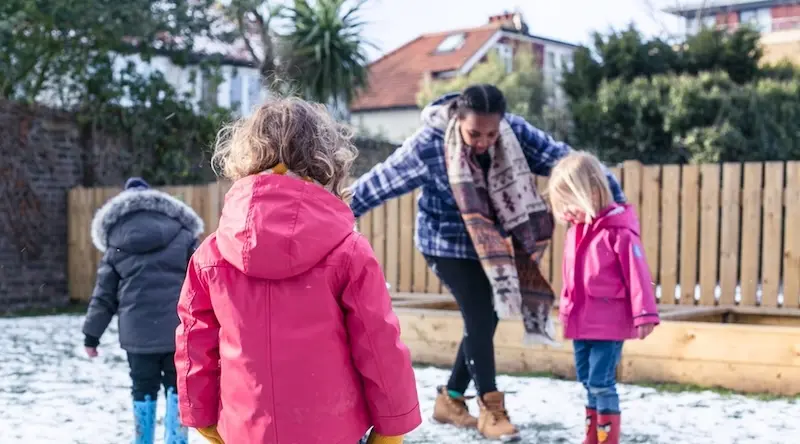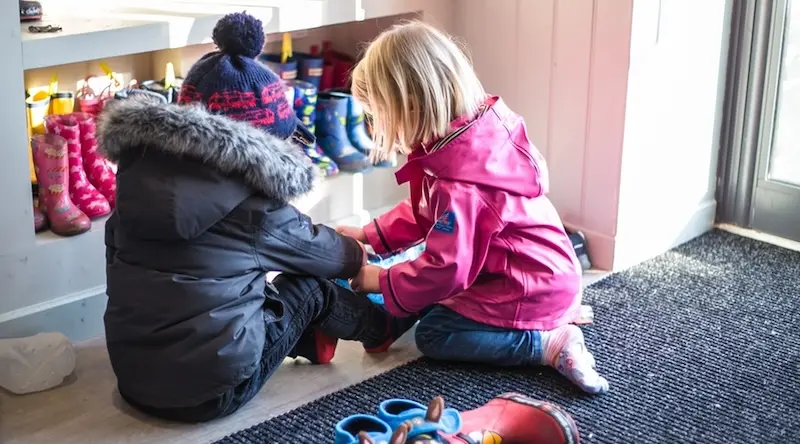settings
children
With Famly since
“Once you have the experience and once you’re secure and confident in it, then absolutely everything can be done through Sustained Shared Thinking.”
Sustained Shared Thinking is more than just another tool to Kathy Brodie. Once you get it right, she thinks it’s a concept that can run through every single part of your practice, helping to explore and support every key area of learning.
Kathy worked in early childhood for over 15 years, now running the globally recognised Early Years TV, and writing some of the most influential early years books out there, including her bestseller about Sustained Shared Thinking. She first came across Sustained Shared Thinking during a course she took in 2008, and as for many others, the focus on natural, instinctive relationships between adult and child instantly resonated with her.
That’s why, when we wanted to learn more about the theory, there was only one person to call…
What is Sustained Shared Thinking in the Early Years?
In the simplest sense, Sustained Shared Thinking is best described as one of those moments with a child where everything else around you just stops.
You’re so absorbed with the conversation or exploration, that the act of working together and taking in what you’re learning about the child is all that matters.

“It’s not necessarily a new idea,” explains Kathy, “those interactions have been around ever since there have been children. But Sustained Shared Thinking is packaged in a way that just clicks with me.”
The official definition of Sustained Shared Thinking can be found in these two influential studies, Researching Effective Pedagogy in the Early Years (REPEY), and The Effective Provision of Pre-School Education (EPPE). The studies, which looked into the development of thousands of children, explain Sustained Shared Thinking as:

“An episode in which two or more individuals ‘work together’ in an intellectual way to solve a problem, clarify a concept, evaluate activities, extend a narrative, etc. Both parties must contribute to the thinking and it must develop and extend.”
- Kathy Brodie, Early Years TV Creator, Author, and Trainer.
The big ideas

There are some key elements in there:
- Working together – The teacher isn’t just presenting information for the child to learn. It’s a partnership, and information flows both ways.
- An intellectual way – The thinking can be practical or theoretical, but it should involve deep thinking and coming to solutions or conclusions.
- Expand on activities - The four activities listed in the definition are not all that counts. There’s room in the definition for you to apply your own experience and understanding.
- Develop and extend – Sustained Shared Thinking can’t be a short dialogue. The dialogue or conversation has to be extended to make sure deep-level thinking takes place and the interaction is memorable for the child.
Another couple of key features are active listening and positive questioning. That means that you’re really deeply engaging with what the child is doing or saying on their level, and that you’re asking the right questions.
What does Sustained Shared Thinking look like in practice?
Kathy has described Sustained Shared Thinking in the past as ‘those lovely, in-depth conversations that you have with children about anything and everything’. But to an outsider, what does that look like in practice?
“You’ll see Sustained Shared Thinking in the body language,” Kathy explains, “The child and practitioner will have very positive body language, usually turned towards one another, with the practitioner down at the child’s height. They’ll either have good eye contact, or they’ll both be focusing on the thing they’re investigating, communicating about it together.”
But what about the conversation itself? According to Kathy, it should be a genuine dialogue, rather than another chance to cram as much vocabulary into the conversation as possible.
“The verbal transaction is at the child’s level too,” she explains, “the teacher isn’t using the opportunity to try and push the language level, but instead using words that help them to communicate with the child in the best way.”

It should look from the outside like both parties are truly engaged, and any question and answer simply comes from the fact that the teacher truly wants to learn about the child and their thinking. That’s what helps the teacher to build a better picture of the child’s experience.
If you’re still struggling to see what sort of interaction this might be, here’s a great example from REPEY:
BOY: [Who has been watching various items floating on water], “Look at the fir cone. There’s bubbles of air coming out.”
EDUCATOR: “It’s spinning around.” [Modelling curiosity and desire to investigate further]
BOY: “That’s ‘cos it’s got air in it.”
EDUCATOR: [Picks up the fir cone and shows the children how the scales go round the fir cone in a spiral, turning the fir cone round with a winding action], “When the air comes out in bubbles it makes the fir cone spin around.”
GIRL: [Uses a plastic tube to blow into the water], “Look bubbles.”
EDUCATOR: “What are you putting into the water to make bubbles?……What’s coming out of the tube?”
GIRL: “Air.”
Why is Sustained Shared Thinking so powerful?
According to Kathy, there are three main reasons why Sustained Shared Thinking has these powerful effects:
- It encourages the act of thinking, by valuing and taking the time to understand the child’s perspective. It makes the child feel safe to propose ideas.
- Teachers model thinking by demonstrating thought processes out loud.
- Thought is extended far beyond the child’s existing ideas, because both parties are sharing knowledge and understanding with each other.
Kathy explains, “I would argue that you can even see Sustained Shared Thinking taking place between a teacher and a baby. I’m thinking of the classic example where a baby drops something, they look, the adult picks it up, they drop it again. What they’re saying is ‘Everything I’m going to drop always goes to the floor’. The adult and baby, they look at each other, sharing the moment. The teacher will be making supportive noises, returning the objects, maintaining eye contact. In my mind, that’s all Sustained Shared Thinking.”
But it’s not only the child that gains from Sustained Shared Thinking. There’s lots in it for you - the staff member - too.
“It’s not just the adult teaching the child, but often in these interactions it can be the child teaching the adult,” says Kathy. “It opens your eyes to children’s potential and prevents you from limiting it. Every so often they will say something that you never knew they could understand, or they share experiences you never knew they had. It opens up your eyes to possibilities and stops you capping their learning. That’s why it’s so powerful.”

“You can just see that lightbulb moment children get when they discover something new, that feeling of ‘Oh wow, now I see why that happens’. That is so exciting as a practitioner, when a child’s face lights up because they’ve made a new connection. For me Sustained Shared Thinking underpins all that, the learning, the role of play, the role of teaching – it draws it all together.”
- Kathy Brodie, Early Years TV Creator, Author, and Trainer.
One of the reasons why Sustained Shared Thinking is so highly regarded is because of the influential research that supports it.
“It comes from a place of robust research,” agrees Kathy, “but it also comes from a place of thought from those researchers. It wasn’t just quickly arrived at, and I think that shows in the definition.”
Here’s just a few examples found in the EPPE and REPEY that support the effectiveness of Sustained Shared Thinking:
- ‘More sustained shared thinking was observed in settings where children made the most progress.’ (EPPE, p. 5)
- ‘…adult-child interactions that involve some element of ‘sustained shared thinking’…may be especially valuable in terms of children’s learning.’ (REPEY, p.10)
- ‘…periods of ‘sustained shared thinking’ are a necessary prerequisite for the most effective early years settings.’ (REPEY, p.11)
- ‘Open-ended questioning and modelling were associated with better cognitive achievement.’ (EPPE p. 6)
There are many reasons why Sustained Shared Thinking is so well regarded in the studies. It generally leads to deep-level learning - that is, learning as more than just remembering facts. It encourages key skills such as critical thinking, problem-solving, and curiosity - skills which lead children to be good life-long learners.
7 ideas to promote more Sustained Shared Thinking
1. Let children play with the ‘facts’
Sustained Shared Thinking needs to be about curiosity, proposing ideas, and thinking about solutions. It’s not necessarily about searching for facts, or the ‘right answer’ but more about in-depth conversations.
“It’s about making a child feel at ease,” says Kathy, “That they’re feeling like they’re going on a journey with you.”
This extract from Iram Siraj-Blatchford and Laura Manni in Nursery World explains this idea perfectly.
“If children are to be encouraged to reflect en route to becoming lifelong learners,” they say, “it's important that they are offered a less fixed view of the world, one where curiosity and wonder, rather than correct solutions and consensus building, fuel their investigations.”
If the adult only wants the correct answer or the best solution, then they’re missing the point. They leave no room for the child to wrestle with their own ideas, thought processes, and concepts, and that’s where the real learning takes place.
2. Ask the right questions
For new teachers who haven’t got much experience with Sustained Shared Thinking, I’d always start with open-ended questions,,” says Kathy. “Questions that start with ‘How’ ‘What’ ‘When’ ‘Why’ and ‘Where’.”
These questions leave all options on the table. They stop the children worrying about getting it right or wrong, allowing them to focus on what they think. That’s why Kathy says you need to be careful with ‘Why’ questions too, even if they are open-ended. It can be hard for the youngest children to grasp the concept of why sometimes, and if they don’t feel like they know the answer, they can easily close themselves down.
That doesn’t mean open-ended questions are the only option you have. In fact, other routes may be much better in certain situations, especially if the child has EAL or is pre-verbal.“
In certain situations, the questioning might not involve your classic open-ended questions,” says Kathy. “It might be a running commentary, or there might not even be any language at all. Because you’re trying to work something out together.”

“Imagine you’re trying to put together an obstacle course and the planks are too short. How could you solve that together? How can you look at it differently? The child might start moving things around to support the plank, the teacher might bring another log over. In that way, you’re thinking together and solving that problem together. So that’s how the communication can be verbal and non-verbal.”
- Kathy Brodie, Creator of Early Years TV, Author, and Trainer
3. Be ready to take the opportunity
Setting aside specific time for teachers to focus on Sustained Shared Thinking is one way you can help them develop the skill. But it’s also about making sure they’re ready at any time when they see that initial spark.
“It could happen anywhere and you have to be ready to jump on those conversations when they start,” says Kathy, “Because it could be at the most unexpected times, waiting for mum, or waiting in line to go to the toilet.”
That’s why it can be helpful to guide your teachers to begin with recognising that initial spark, so that they can spot the curiosity of the child and help to sustain that thinking for as long as possible.
4. Support educators with peer-to-peer observations
“Because it's such a practical thing – when you see it, you get it – I always advise that you do peer observations to help train Sustained Shared Thinking,” explains Kathy.
To support peer observations, you’ll need to recognise the members of your team who are strong at Sustained Shared Thinking, and give inexperienced teachers time to watch and learn from them.
“Choose someone who is really good at Sustained Shared Thinking in the book corner, for example, and either have the less experienced teacher watch them or video it,” says Kathy. “The key is that you let those teachers talk afterwards so that both of them can understand why they made those decisions in the moment.”
Often, the questioning can even help the more experienced teacher to understand why they do things that seem like simple instinct, helping everyone’s practice improve.
If you don’t have the resources, Kathy recommends Siren Films’ video recordings of Sustained Shared Thinking in action. But the best way is to try and do it in your center, so you have that time for reflection, and teachers understand the practice in the context of your environment and children. “If you can do it in your own setting, then that’s the gold standard,” explains Kathy.

5. Practice Sustained Shared Thinking as a group
It’s not only an adult and child that can engage in Sustained Shared Thinking. Other children can also have things to offer one another in a group scenario.
“Children can learn from each other through Sustained Shared Thinking,” says Kathy, “because they might have different experiences. The teacher needs to know when to stand back, and allow them to learn from each other because learning from your peers is often far more powerful.”
This is where the truly experienced teacher knows when to get involved, and when to stand back. And that’s just something that comes with experience.
6. Build your environment right
One great way to spark more episodes of Sustained Shared Thinking is by setting up your environment up for provocation. Kathy has talked in the past about how leaving trails of curiosity can provide the best conversation starters. It could be as subtle as a tiny door left in a skirting board, or a peacock feather in the garden with some glitter leading to it.
You can tailor these provocations to match child interests in order to make sure they’re more engaged, and that’s where Sustained Shared Thinking can really come into its own. By having extended, curiosity-filled conversations, the child’s interests can be extended further and further.
More importantly, you learn more about those interests and where they come from. Do they like dinosaurs because they’re mysterious and old? Or is it because they’re ferocious and big? Once you understand the thinking behind the interest, it’s easier to extend that interest more broadly.
Provocation aside, it is important that you have the space in your center for one-on-one conversations.
“We often advise having cosy corners or quiet areas to talk together,” says Kathy, “Which I would absolutely recommend because it is important to have areas where you can withdraw one-to-one.”

7. Understand the role of parents and carers
The home learning environment of your children is going to have a big impact on how prepared your children are for quality Sustained Shared Thinking to take place.
As you well know, there can be many differences in the home learning environment in different households. It’s important not to add any extra pressure to parents without understanding the pressures they’re already under.
Kathy recommends that you:
Share conversations that you’ve had at the center with parents. Sometimes they can add more context and extend the thinking further. Find out about the home learning environment, in a sensitive and appropriate way, and suggest opportunities for Sustained Shared Thinking, such as having conversations during bath time or sharing books together at bedtime. Try not to make assumptions, especially about families having spare time in the evenings – they may be working shifts or have other care responsibilities.Suggest conversations with grandparents or other adults who spend time with the children, who may have more time and interesting experiences to share.
Try learning journals for free
Add observations, and build digital learning journals to share with families instantly. All with your completely free 14-day trial.
Get started









